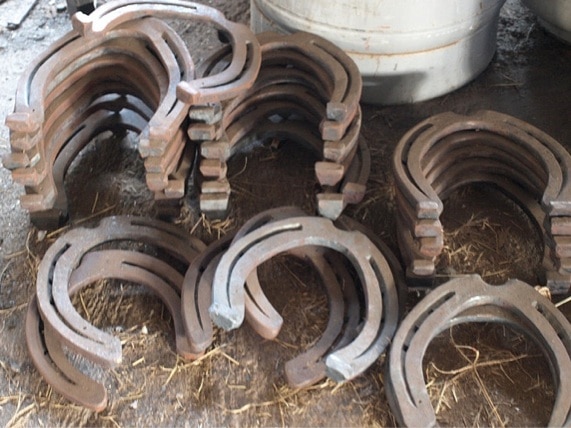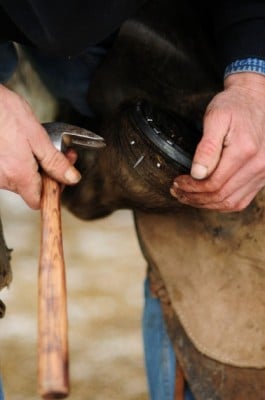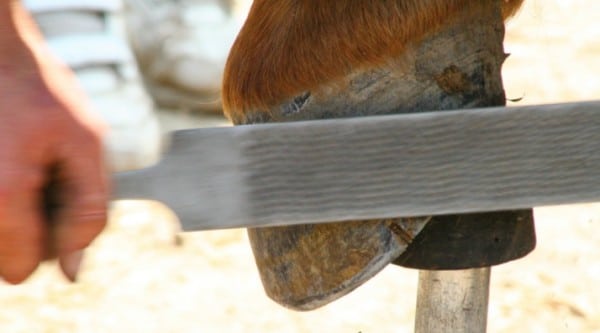Alex Hunter recently completed a four-year apprenticeship and qualified as a farrier – a profession traditionally dominated by men – so she can now use the letters Dip WCF after her name.
She is in the early stages of building up her business, aiming to shoe around six horses a day. “I work in and around Ystrad Mynach (Wales) but cover the Vale of Glamorgan and some surrounding areas,” she explains.
Although she has scars from the odd bite and kick, those with more placid natures seem to remain calm when she is around them. Alex even seems to have the gift to calm horses with reputations for being tense and nervous when being shod.
“I think horses do relax when they see a woman because most have female owners. Men tend to be the vet who gives them an injection or the farrier who yanks their legs,” she says.
Yanking of limbs is not an approach Alex favors. At 5’6″ and of slight frame, she prefers a gentle approach, and it works.
“I think horses can sense that in general women are more gentle and less threatening; we don’t use brute strength when they’re being difficult,” she says.

She still remembers the day when she told her mother she wanted to work with horses. “She tried to put me off because she said I wouldn’t enjoy horses as a hobby any longer if I worked with them. In a sense she was right because I don’t have time to ride any more but I do get to be around horses every day.”
To become a farrier, Alex served an apprenticeship in her home county of Staffordshire with master farrier, Jonathan Nunn, and excelled in both the practical and theoretical side. “I was the only female on the course so I got a bit of stick for that, but I managed to score the highest marks in my year for my written paper and so was presented with the David Llewellyn Award from the farriers’ training agency, as well as getting first runner-up for best portfolio.”
1. The most common size steel horseshoe is a size 2. One size 2 shoe weighs 440 g. How much would 4 shoes weigh?
When she passed her diploma, she set herself up in business as a mobile farrier and was fortunate to secure funding from the Rural Development Plan for Wales. The grant, delivered by Caerffili Cwm a Mynydd, has helped her buy specialist equipment and to market her business.

It usually takes Alex around an hour to give a horse a full set of shoes, but that’s not always the case. “Some horses do have issues such as nervousness, but I try to give these all the time they need so that they are able to relax. Customers seem to really appreciate the time spent to keep the horse stress-free.”
2. Normally seven nails are used, though the number may vary depending on the condition of the hoof. Assuming 7 nails for each shoe, how many nails will be used for all 4 shoes?
Some horses, particularly older animals, react when their legs are lifted, but this is often because they have arthritis. “They are not being naughty – they are just in pain. When this happens, I have been known to shoe with their feet on the floor to try to keep them more comfy,” says Alex.
But even the most patient and calm farrier will fail to overcome the most volatile horses. Alex admits it does help to have a high pain threshold. “Things can happen, even with good horses. I do get kicked a lot, but that’s why I wear chaps and boots with steel toecaps. It’s part of the job, you deal with it.”
During her apprenticeship, she learned the biomechanics and disease issues of a horse from the knee and hock down. There was also the practical experience of working with horses and learning to make the different types of shoe. “We were taught to make traditional shoes as well as the more modern ones. Some owners like the traditional ones more because they encourage the horses to pick their feet up, something often seen with showing Welsh Cobs and Hackneys, but they can be a bit slippery for working on the road,” says Alex.

She has won three national awards, including becoming the only female farrier ever to receive the Best Forging Skills award, presented by the National Farriers Training Agency. She has also been successful in competitions, winning the Myerscough contest in the shoeing class and placing third in both the therapeutic class at the Three Counties Show and at the Middlewich Competition.
Alex is in no doubt that training as a farrier is the best decision she has ever made. “I think horses are fantastic and how lucky am I to be able to earn a good living from being around them all day. I really look forward to going to work in the mornings.”
The original article includes a photo of Alex.
Farrier Schools
Here’s a list of Farrier Schools in Canada.
Here’s a list of Farrier Schools in the United States.
Here’s a list of Farrier Schools in the United Kingdom.
Alex Starts Up Her Own Farrier Business Answers
1. The most common size steel horseshoe is a size 2. One size 2 shoe weighs 440 g. How much would 4 shoes weigh?
Answer: 4 x 440 = 1760. Four steel size 2 horseshoes weighs 1760 g.
2. Normally seven nails are used, though the number may vary depending on the condition of the hoof. Assuming 7 nails for each shoe, how many nails will be used for all 4 shoes?
Answer: 4 x 7 = 28. The farrier would need 28 nails to shoe one horse.
Photos:
Title photo: IMG_4490 by Lily M; CC BY 2.0
2nd: Farrier Visit to CAM Forge by The Travelista; CC BY 2.0
3rd: Nails by sk8geek; CC BY-SA 2.0
4th: IMG_4519 by Lily M; CC BY 2.0







